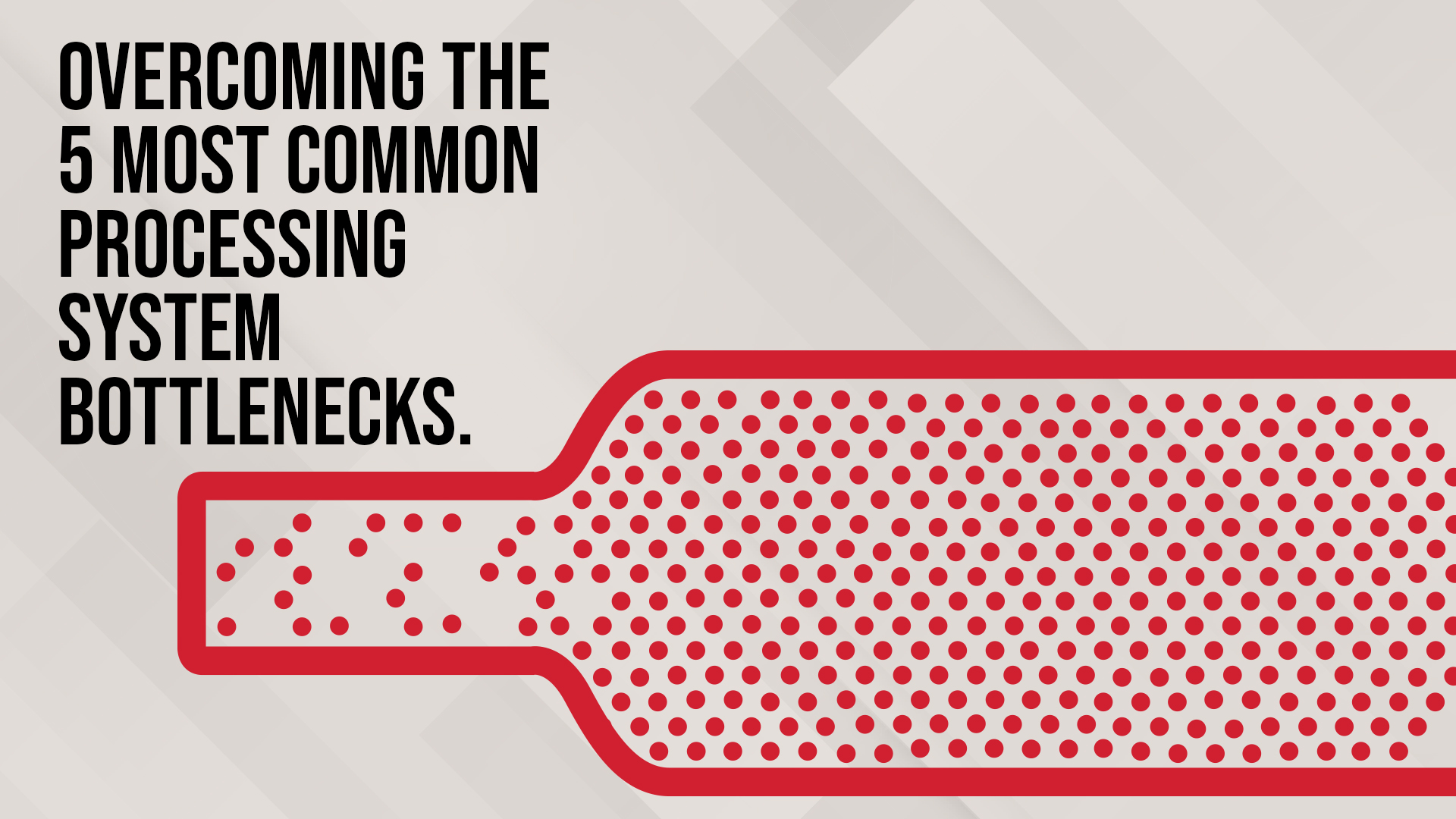
Our service techs, engineers, and application experts have pinpointed the five most congested production areas in food manufacturing plants. Here are their tips for mitigating these delays, starting with the loading of a system:
#1 Bottleneck: Inefficient and Ineffective Loaders
A common bottleneck is slow loading times preventing the start of batch mixing or blending. Some processors struggle with effective loading using non-integrated, manually intensive equipment causing higher than expected load times and product waste due to ineffective design for the application.
Ineffective feeding methods also add to processing bottlenecks including delays in food product barreling and other issues with non-positive conveyance.
Mitigation: While some efficiencies may be gained from an efficiency audit, new equipment solutions might be considered with an integrated recipe and process control package that drives automation. Depending on the consistency of the product, Screw conveyor and Belt Conveyor systems can be designed for the application to provide the necessary feed rate to load quickly and efficiently while maintaining product integrity and temperature. If the product must be delivered from a buggy, combo or vat, Column Dumpers or Vat Dumpers can also be designed for the application and fully integrate with the system.
#2 Bottleneck: Over-blending
While it seems like systems will gain more throughput from over-filling, it creates the opposite effect of over-blending and is a waste of production time and efficiencies. The consequences of over-blending are extended load/discharge and blend cycle times. A slight increase in the batch size leads to losses in the overall production rate, sacrificing quality and accuracy.
Some production bottlenecks are caused by inefficient feed rates or lack of surge, causing another case of over-blending.
Mitigation: The process may benefit from a different agitator to produce a quicker, more effective blend. It may also be a process issue where the recipes and timing require tuning to control the blender more efficiently.
The system may warrant an efficiency audit and adjustment to reach the gains and efficiency possible from the equipment. Some customers schedule yearly efficiency audits, having discovered that the service calls pay for themselves in improved quality, accuracy, and
throughput.
An efficiency audit may address inefficient feed rates, or a new equipment solution with surge loading may offer more automation.
#3 Bottleneck: Overtaxed Agitators
Mixers and Blenders are the workhorses of a food processing line. It is vital to keep them well maintained. Flexed or stressed agitators do not perform efficiently and in some cases minor efficiencies turn into critical downtime scenarios when not maintained properly.
Mitigation: The drive end motor may not be shimmed properly. A bad bearing on the idle side may be creating flexing in the agitator. Over chilled food product will cause additional stress on the agitation
process.
It is critical to understand the expected performance of your mixer or blender as well as the maintenance and inspection of the agitator(s). If plant personnel make a repair, it is important to schedule an after-event service call to make sure the repairs hold up to stainless welding
fortifications and proper straightening to prevent future issues. There is a 3-month to 6-month lead time on replacement agitators. High volume processors often keep a spare agitator in inventory in the event of a critical agitator repair, so production can continue
using the inventoried agitator.
#4 Bottleneck: Cooker Scraper Damage and Performance
Batch cookers set the pace for downstream processes and production goals in a prepared foods production line. It is not uncommon to run cookers for long periods, especially by high-volume producers. Scraper systems may degrade prematurely when preventative maintenance is stretched too far between intervals. Worn scrapers are a liability to food safety and product quality that can cause a critical shut-down if scrapers crack or break up into the food product; or become ineffective due to excessive wear.
Mitigation: Mepaco® field services experts recommend always having a complete set of scraper assemblies (including springs) in inventory. High volume processors often create blanket orders to maintain a steady inventory of scraper assemblies.
A preventative maintenance check on the scrapers is just as important to prevent downtime associated with scrapers. Evidence of product burn-on and product build-up is a sign that the scrapers are worn. It is important to note scraper usage compared to the hours of operation. Maintenance checks and sanitation protocols should include checking scrapers for cracks, missing pieces, and other signs of stress or wear.
#5 Bottleneck: Manual or Inefficient Unloading
When cookers or mixers are manually unloaded into buggies or vats, several minutes of production are lost compared to automatic solutions. The equipment must be shut off, the operator must manually remove product around the doors, then close the doors before taking the tote by fork truck to the dumper.
Mepaco® techs have also seen delays with unloading when downstream equipment is not ready or can’t keep up with the cooker or mixer.
Mitigation: In manual unloading situations, equipment such as screw conveyors, metering screws or pump feeders may be able to be planned into the system to automate the process, even as a retrofit, if the floor layout allows.
In situations where downstream equipment does not allow for product, Mepaco® has engineered buffering mixers, which will maintain the mix and the temperatures, in a holding state until signaled by downstream equipment. The blender can continue production when the previous batch is discharged into the buffering mixer.
The greatest efficiencies in a processing system result from a coordinated effort to automate the processes in the system by determining:
- Feasibility for combined cooking and blending operations utilizing fewer equipment solutions
- Reduced cooking and cooling cycles integrating CO2 or vacuum
- Integrating accumulation and buffering to drive continuous production
- Smart controls that engage simultaneous processes to prevent gaps in machine processing time
